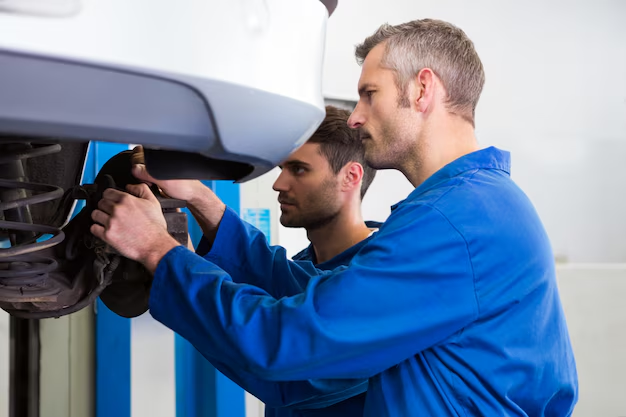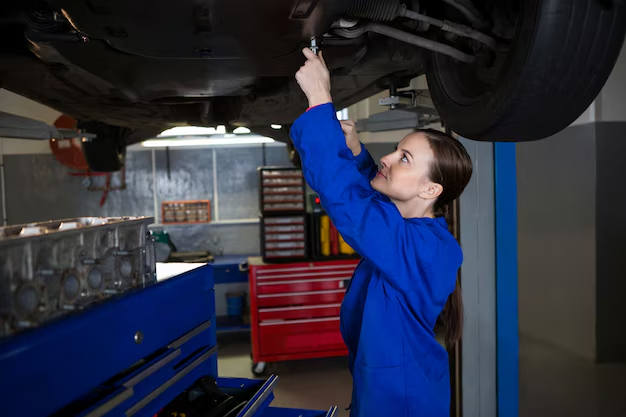Imagine you’re cruising through Lomita on a rainy afternoon. Suddenly, the car in front of you slams on the brakes. You instinctively stomp on your brake pedal—and instead of skidding uncontrollably, your car pulses gently and comes to a controlled stop. That’s not luck. That’s your Anti-lock Braking System (ABS) kicking in.
ABS technology is one of the most important safety features on modern vehicles, yet many drivers don’t really know how it works, or just how much it does to protect them on the road. If you’ve ever wondered what ABS is all about, how it functions, and why it matters, this guide is for you.
Let’s break it down in simple, no-nonsense terms.
What Is ABS and Why Was It Invented?
ABS stands for Anti-lock Braking System. In essence, it’s a safety system designed to prevent your wheels from locking up during hard braking. When a wheel locks—meaning it stops rotating while the car is still moving—it causes the tire to skid. That skid reduces your control and increases your stopping distance.
Back in the day, before ABS technology became standard, drivers had to “pump” their brakes manually in emergencies to avoid a skid. It took skill, timing, and luck. ABS automates that entire process using sensors and onboard electronics. It works faster than any human ever could, applying and releasing braking pressure at just the right times to keep your tires gripping the road.
How Does Anti-lock Braking Work?
At its core, ABS is a computer-controlled system that monitors wheel speed and controls brake pressure. Here’s a step-by-step look at what happens:
- Wheel Speed Sensors: Each wheel has sensors that constantly measure how fast it’s spinning. The ABS computer (called the control module) uses this information to detect when a wheel is about to lock up.
- Hydraulic Valves and Pump: If the system detects a wheel slowing down too quickly (indicating a lock-up), it activates hydraulic valves to reduce brake pressure. When the wheel regains traction, pressure is reapplied. This cycle can repeat multiple times per second.
- Pulsating Brake Pedal: Ever felt your brake pedal vibrating during a hard stop? That’s the ABS system doing its job—adjusting pressure rapidly to prevent a skid.
- Continuous Feedback Loop: The system keeps checking, adjusting, and reapplying pressure until the car is stopped or back under control.
The result? Maximum braking force without losing grip or steering control.
Why ABS Technology Matters for Vehicle Safety
Let’s be real—roads aren’t always dry, straight, or predictable. In Lomita and beyond, drivers deal with everything from slick highways to unexpected stop signs on narrow residential streets. That’s where ABS shines.
Here’s what makes ABS a true game-changer for vehicle safety:
- Maintains Steering Control: Locked wheels mean you’re sliding, not steering. With ABS, you can still maneuver while braking—possibly avoiding a collision altogether.
- Reduces Stopping Distance on Slippery Roads: While ABS doesn’t always shorten stopping distances on dry pavement, it significantly improves braking performance on wet or icy roads.
- Helps Prevent Accidents: According to the National Highway Traffic Safety Administration (NHTSA), vehicles with ABS are significantly less likely to be involved in fatal crashes, especially when roads are slick.
- Boosts Driver Confidence: Whether you’re a seasoned commuter or a new driver heading out for the first time, ABS gives you a layer of protection that’s always working in the background.

ABS in Action: Real-World Scenarios
Sometimes the best way to understand a safety system is to imagine how it helps in everyday driving. Here are a few common scenarios where anti-lock brakes make all the difference:
Scenario 1: Sudden Stop on a Wet Road
You’re headed to a local coffee shop when traffic suddenly slows. You hit the brakes, but the road is slick from overnight rain. Without ABS, your wheels could lock, and your car might slide into the vehicle ahead. With ABS, your car stays in control, slowing down quickly and safely.
Scenario 2: Braking in a Curve
Let’s say you’re turning left at a busy intersection and someone runs a red light. You need to brake fast. If your wheels lock in the turn, your car could spin out. ABS minimizes that risk by managing each wheel’s traction, helping your car stay balanced through the turn.
Scenario 3: Emergency Braking on Gravel
Braking hard on loose surfaces like gravel or sand often leads to skidding. ABS adjusts to the conditions, allowing controlled braking that reduces your chance of sliding off the road.
Are There Any Downsides to ABS?
While ABS offers critical benefits, it’s important to understand its limitations:
- Increased Stopping Distance on Loose Surfaces: On gravel or deep snow, ABS may actually increase stopping distance slightly. That’s because it’s working to maintain traction, not just to stop the car.
- False Sense of Security: ABS helps control your vehicle, but it doesn’t defy physics. You still need to drive carefully, especially in bad weather or poor road conditions.
How to Know if Your ABS Is Working
Most vehicles have an ABS warning light on the dashboard. When you start the engine, it lights up briefly as the system self-checks. If the light stays on, it means there’s a fault in the ABS system, and you should have it looked at right away.
A functioning ABS system is largely invisible during regular driving. But if you brake hard in an emergency and feel a pulsing in your pedal, that’s a sign it’s working exactly as it should.
Can You Drive Without ABS?
Technically, yes—but it’s not recommended. In fact, since 2012, ABS has been legally required on all new cars sold in the U.S. Driving without ABS puts you at greater risk in emergency situations. If your ABS light is on or you suspect a problem, it’s worth getting checked by a trusted technician.
Maintaining Your ABS System
The good news? ABS requires very little maintenance. But like any system, it depends on clean sensors and functional brake components. Here’s how to keep it working:
- Routine Brake Inspections: Regular inspections will catch worn-out parts that could affect ABS performance.
- Fluid Checks: Brake fluid should be clean and topped up. Contaminated fluid can impact the hydraulic side of your ABS.
- Sensor Cleaning: Debris or rust on wheel speed sensors can trigger false readings. These should be inspected and cleaned if needed.
At Hillside Auto Clinic in Lomita, CA, our experienced team knows exactly how to keep your braking system, including ABS, in top shape. Whether you need diagnostics, repairs, or preventive maintenance, we’ve got the skills and tools to help.
When it comes to your safety on the road, the little things matter. ABS might not be flashy, but it works behind the scenes to make every drive safer, rain or shine. Understanding how anti-lock brakes work and how they benefit your vehicle can give you greater peace of mind, whether you’re navigating rush hour traffic or just running errands around Lomita.
If your ABS warning light is on, your brakes feel off, or it’s simply time for a routine checkup, don’t put it off. Schedule your visit with Hillside Auto Clinic today and let our team take care of your vehicle the right way. We offer honest service, top-quality repairs, and prices that make sense, with flexible payment options through Snap Finance to keep things stress-free.
Book your appointment online now or call us to experience reliable, affordable auto care right here in Lomita. Your safety is our priority.

